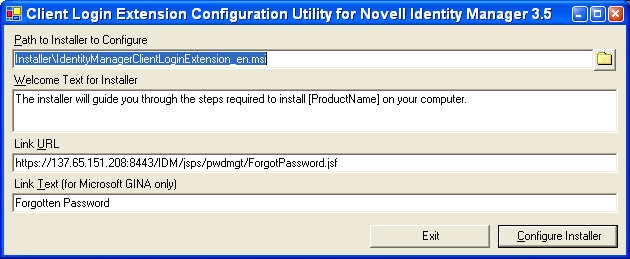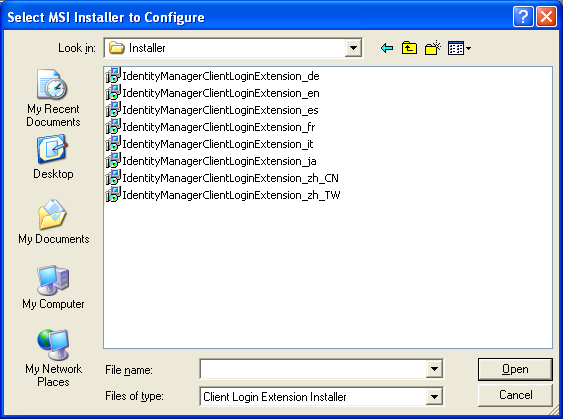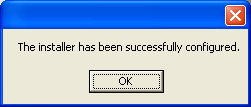8.3 Using the Client Login Extension Configuration Utility to Configure the Client Login Extension MSI Files
-
Click the shortcut to launch the Client Login Extension Configuration utility.
Or you can double-click the ClientLoginExtensionConfigurationUtility.exe file to launch the utility.

The option shows the path to the English version of the Client Login Extension installer file being configured. Whenever this text box contains a path to a valid MSI file, the utility automatically opens the file, populates the other controls with the information it contains, and enables the button.
-
(Optional) If you want to select another language, click the button to select a Client Login Extension installer file in a different language.
By default, the button opens into the Installer subfolder in the installation folder and displays all files that match the Client Login Extension Installer pattern.

-
Modify the information in the Welcome text, or keep the information as it is presented.
The information in the text box is displayed in the Welcome screen of the Client Login Extension. The string displays as “.”
-
Specify the URL that the Client Login Extension restricted browser uses to connect to the User Application’s Forgotten Password page. You can use either a DNS name or an IP address. An example URL using a DNS name that links to the Forgot Password page is:
https://hostname:8443/IDM/jsps/pwdmgt/ForgotPassword.jsf
This can also be configured to access the external password WAR. To do this, see Chapter 5.8.4, “Accessing the External Password WAR,” in the Identity Manager 3.5 Installation Guide.
IMPORTANT:You must have a valid URL pointing to the User Application’s Forgotten Password page; otherwise, the client connection fails and you might not be able to log in through the workstation. For more information, see Section 8.5.1, Troubleshooting.
-
If you have workstations that are using the Microsoft GINA, specify the text to be displayed on the link to the restricted browser that the Client Login Extension uses.
The default text is . The text for the button in the Novell Client is provided by the Novell Client and cannot be changed here.
-
After all of the information is in place, click to write the new configuration settings to the selected Client Login Extension file.

-
Click to close the confirmation message.
-
The Client Login Extension Configuration utility remains open, allowing you to configure another Client Login Extension MSI file in a different language. To do so, click the button to the right of the option, select another language, and configure another .msi file by following Step 2 through Step 7.
Localized Client Login Extension MSI files for the more common languages are delivered with the configuration utility in the Installers folder. You must configure each localized installer individually.
To localize the Client Login Extension MSI files for languages other than those delivered with the Client Login Extension, see Section 8.3.1, Localizing Client Login Extension Files for Other Languages.
-
To close the Client Login Extension Configuration utility for Novell Identity Manager 3.5 window, click .
NOTE:You cannot run the Client Login Extension MSI file while it is open in the Client Login Extension Configuration utility.
8.3.1 Localizing Client Login Extension Files for Other Languages
To localize the Client Login Extension for languages other than those delivered with the Client Login Extension Configuration utility, you can use Orca to directly edit the content of the MSI database (IdentityManagerClientLoginExtension.msi).
Orca (Orca.exe) is a database table editor for creating and editing Windows Installer packages. It is available in the Windows SDK Components for Windows Installer Developers.
The text to be localized for IdentityManagerClientLoginExtension.msi is located in the following table.
Table 8-1 Text You Need to Localize
WARNING:Translate only the user interface text. For example, do not translate text that is surrounded by square brackets ([xxxx]), or is in mixed case (XxxXxxXxx). Modifying these property names and identifiers breaks the installer.
Use the following procedure to localize the Client Login Extension MSI file to a new language:
-
Copy IdentityManagerClientLoginExtension.msi to IdentityManagerClientLoginExtension_xx.msi, where xx identifies the new language (locale).
-
Open IdentityManagerClientLoginExtension_xx.msi in Orca.exe, edit the tables and columns as they are listed in Table 8-1 to insert the localized text, then save and close the file.
-
Open IdentityManagerClientLoginExtension_xx.msi with the Client Login Extension Configuration utility (ClientLoginExtensionConfigurationUtility.exe), review the default values, make any modifications if needed, then click .
NOTE:Step 3 is required, even if the default values that you set in the Registry table do not need modification. The Client Login Extension Configuration utility makes additional changes that enable the Client Login Extension MSI file.